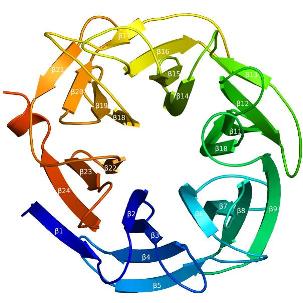CAZypedia needs your help! We have many unassigned GH, PL, CE, AA, GT, and CBM pages in need of Authors and Responsible Curators.
Scientists at all career stages, including students, are welcome to contribute to CAZypedia. Read more here, and in the 10th anniversary article in Glycobiology.
New to the CAZy classification? Read this first.
*
Consider attending the 15th Carbohydrate Bioengineering Meeting in Ghent, 5-8 May 2024.
Difference between revisions of "Glycoside Hydrolase Family 93"
| Line 30: | Line 30: | ||
== Catalytic Residues == | == Catalytic Residues == | ||
| − | From the crystal structure of Arb93A, Glu170 and Glu242 are proposed to act as nucleophile and acid/base respectively. Mutagenesis experiment support their role in catalysis and they are strictly conserved between the family members. | + | From the crystal structure of Arb93A, Glu170 and Glu242 are proposed to act as nucleophile and acid/base respectively. Mutagenesis experiment support their role in catalysis and they are strictly conserved between the family members. [3] |
== Three-dimensional structures == | == Three-dimensional structures == | ||
Revision as of 08:36, 28 July 2009
- Author: Annabelle Varrot
- Responsible Curator: Annabelle Varrot
| Glycoside Hydrolase Family GH93 | |
| Clan | GH-E |
| Mechanism | retaining |
| Active site residues | known |
| CAZy DB link | |
| http://www.cazy.org/fam/GH93.html | |
Substrate specificities
The characterized member of family 93 are known to hydrolyse α-1,5-L-arabinan. EC:3.2.1-
Kinetics and Mechanism
GH93 enzymes are exoenzymes which only release arabinobiose from the non-reducing end. Net retention of the configuration of the anomeric carbon is proposed from the products of the transglycosylation activity of the protein Abnx from Penicillium chrysogenum. It was recently supported in the crystal structure of the Arb93A enzyme from Fusarium graminearum in complex with arabinobiose.
Catalytic Residues
From the crystal structure of Arb93A, Glu170 and Glu242 are proposed to act as nucleophile and acid/base respectively. Mutagenesis experiment support their role in catalysis and they are strictly conserved between the family members. [3]
Three-dimensional structures
The recent crystal structure of Arb93A reveals a six-bladed beta-propeller fold characteristic of sialidases of clan GHE. The catalytic machinery is however very different from that of sialidases. [3]
Family Firsts
First sterochemistry determination
This was determined with the Abxn enzyme using the H1-NMR technique to follow the products of its transglycosylation activity [2]
First catalytic nucleophile identification This was proposed based on the structure of Arb93A [3]
First general acid/base residue identification This was proposed based on the structure of Arb93A [3]
First 3-D structure Determined for Arb93A by Carapito and co-workers [3]
References
1. Sakamoto T and Thibault JF. Exo-arabinanase of Penicillium chrysogenum able to release arabinobiose from alpha-1,5-L-arabinan. Appl Environ Microbiol 2001 Jul;67(7) 3319-21. pmid:11425761. [1]
2. Sakamoto T, Fujita T and Kawasaki H. Transglycosylation catalyzed by a Penicillium chrysogenum exo-1,5-alpha-L-arabinanase. Biochim Biophys Acta 2004 Sep 6;1674(1):85-90. pmid 15342117. [2]
3. Carapito C, Imberty A, Jeltsch J-M, Byrns SC, Tam P-H, Lowary T L, Varrot A and Phalip V. Molecular basis of arabinobio-hydrolase activity in phytopathogenic fungi. crystal structure and catalytic mechanism of fusarium graminearum GH93 exo−α−L-arabinanase. J Biol Chem 2009 May 1;284(18) 12285-96. pmid:19269961. [3]
